
Longburn railway station was a station in Longburn, on the North Island Main Trunk in New Zealand. The platform, which is across from the Fonterra Factory, remains but the structure has been demolished.

Awapuni railway station was a station in Kairanga County, on the Foxton Branch and, from 1908, the North Island Main Trunk in New Zealand, now in the Palmerston North suburb of Awapuni. It was beside the Mangaone Stream, near its confluence with the Kawau Stream, about 400 m (440 yd) west of Maxwells Line on the north side of Pioneer Highway. Nothing remains of the former station, except a wide verge, partly occupied by a cycleway, built in 2015.

Greatford railway station was a station on the North Island Main Trunk (NIMT) in New Zealand, south of Marton. It is in the Manawatū-Whanganui region. Only a substation and a passing loop remain.
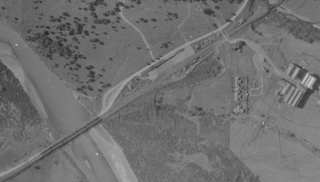
Kakariki railway station was a station on the North Island Main Trunk and in the Manawatū-Whanganui region of New Zealand.
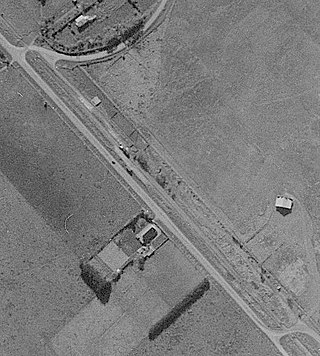
Taonui railway station was a station on the North Island Main Trunk and in the Manawatū-Whanganui region of New Zealand. From 1879 to 1886 it was the junction for the Taonui Branch. A passing loop remains at the station site.

Bunnythorpe railway station was a station on the North Island Main Trunk in New Zealand, serving the village of Bunnythorpe.

Utiku railway station was a station on the North Island Main Trunk in New Zealand, and in the Manawatū-Whanganui region. It opened in 1904 and closed in 1986. It was part of the 13+1⁄2 mi (21.7 km) Mangaweka to Taihape section, officially opened by the Prime Minister, Richard Seddon, on 21 November 1904. It closed in 1986. A passing loop remains.

Winiata railway station was a station on the North Island Main Trunk in New Zealand. It was decorated with an archway when the 13+1⁄2 mi (21.7 km) Mangaweka to Taihape section was opened by the Prime Minister, Richard Seddon, on 21 November 1904.

Cliff Road railway station was a flag station on the North Island Main Trunk in New Zealand. It opened in 1888 and closed in 1982. Only a single track now passes through the station site and no buildings remain.
Ngāti Kauwhata is a Māori iwi (tribe) located in the Manawatū-Whanganui region of New Zealand. The iwi has ancestral ties to Tainui Waka and Maungatautari. The iwi has two main marae, Kauwhata Marae & Aorangi Marae.

Feilding railway station was a station on the North Island Main Trunk line in Feilding, New Zealand. It was opened on 1 October 1876 and closed on 25 June 2012. The station is now used by Feilding Information Centre and an occasional excursion train.

Marton railway station was a station and rail junction on the Marton–New Plymouth Line, opened on 4 February 1878. After the North Island Main Trunk (NIMT) made a junction to the south of Marton, a new station was built there and the old station renamed and downgraded, in 1898.
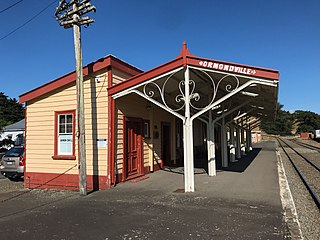
Ormondville is a locality in the Manawatū-Whanganui region of New Zealand's North Island. It is located inland, south of Waipukurau and west of Flemington, Hawke's Bay.
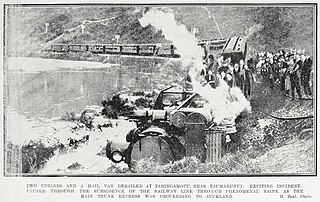
Taringamotu railway station was a station at Taringamotu on the North Island Main Trunk, in the Ruapehu District and Manawatū-Whanganui region.
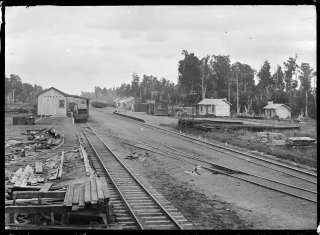
Pokaka was a station on the North Island Main Trunk line, in the Ruapehu District of New Zealand. It served the small village of Pokaka and lay to the south of Makatote Viaduct, the late completion of which held up opening of the station.

Erua was a station on the North Island Main Trunk line, in the Ruapehu District of New Zealand. It served the small village of Erua. For a month in 1908 it was the terminus of the line from Auckland. Makatote Viaduct and tramway are about 3 mi (4.8 km) south of Erua.

Matamau is a small village, on a ridge between the Matamau and Whakaruatapu Streams, tributaries of the Manawatū River, in the Manawatū-Whanganui region of New Zealand's North Island. State Highway 2 and the Palmerston North–Gisborne line run through the village. It has a rare surviving example of a basic railway station, a cafe, developed from the former post office and store about 1969, and a truck repair workshop. Until the 1870s it was densely forested, but most of the trees were felled and milled by 1910 and replaced by farms.
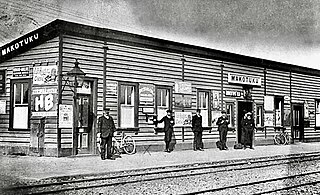
Makotuku is a locality in the Manawatu-Whanganui Region of New Zealand's North Island, about 3 km2 (1.2 sq mi) west of Ormondville.

Kopua in New Zealand is now a sparsely populated area, immediately south of the border of the Manawatū-Whanganui and Hawke's Bay regions, with 150 people scattered over a 40 km2 (15 sq mi) meshblock. For two years it briefly flourished as a village, centred on a railway station on the Palmerston North–Gisborne line, opened on 25 January 1878, when it became the southern terminus of the line from Napier and Spit. Building to the south was delayed by the need to erect 3 large viaducts over the Manawatū River and its tributaries, so the extension to Makotuku didn't open until 9 August 1880. Kopua then declined until the station closed on 8 May 1977. Only a single line now passes through the station site and there are remnants of cattle yards.

Piripiri is a sparsely populated area in the Tararua District, in the Manawatū-Whanganui Region, on State Highway 2 and the Palmerston North–Gisborne line. It is 3 mi 8 ch (5.0 km) north of Dannevirke, and has 150 people scattered over a meshblock of 21.8 km2 (8.4 sq mi).



















